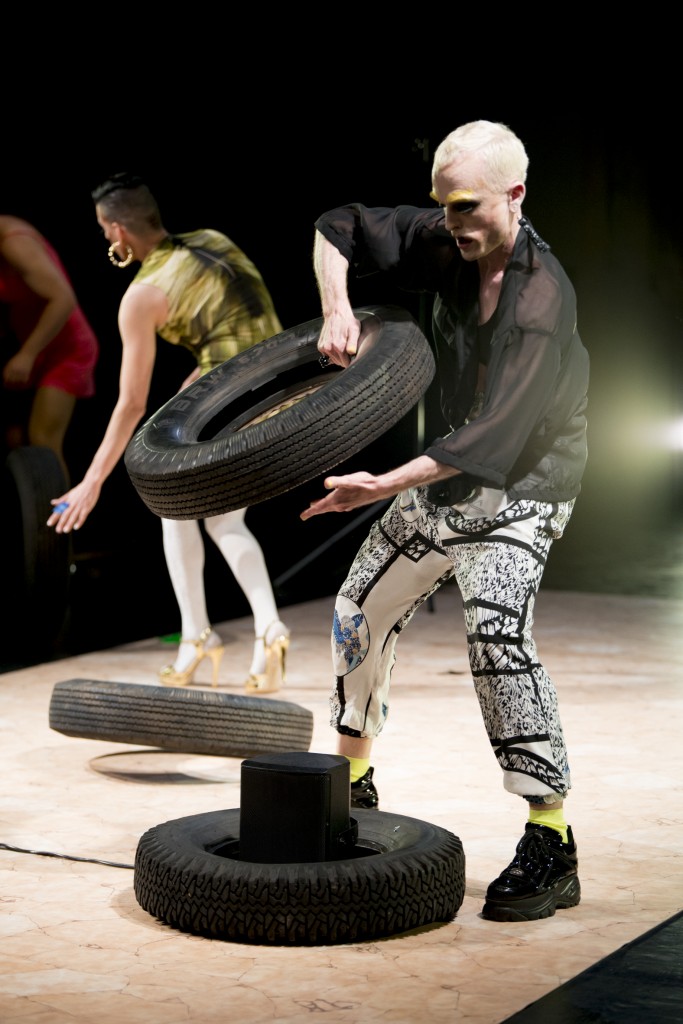Schönheitsabend is a performance created and performed by Florentina Holzinger and Vincent Riebeek. It is a collage of references taken out of context and manipulated in ways that makes us experience them differently and messes with ideas of dramaturgy, puts beauty right next to silly, romantic next to cheap, formal next to trashy, sexy pole dance next to dramatic ballet. The experimental approaches popular, megalomaniac or avant-garde meets lame and skillfulness overlaps just-enough. Or other ways around, but it restructures sensuous relationships between things. In that sense, one could put it under the label “postinternet”, because dance history is no longer necessarily chronological, and what is considered dance history does not anymore have to be confirmed by the same gate-keepers. The internet does not only change what is archived and available, but probably also how we are conditioned to or abled to think dramaturgy. The way of using and mis-using dance history is made even more exciting because of Holzinger’s and Riebeek’s way of executing the material in an almost sport like manner, and by insisting on transforming the heteronormative heritage into something queer, in which gender roles are dispersed, re-written or opposed.
The opening of Schönheitsabend is a scene from a ballet that is performed convincingly but technically not especially well executed. Florentina Holzinger enters the state in a remarkable, very long, red, glittering robe, platina blond hair and makeup enough to fit into the opera ballet. The heterosexual love story and the display of beauty and conventional romance through the vocabulary of ballet make ballet float since it is not contextualized by the opera house or performed to perfection but executed more like just-enough-good. Here it is, in the most glorious costumes and full-on sound, the gestural expression well worked but with the technical excellence removed. What can be taken away from the form, for it to still be intact? What is this dance, ballet, when re-contextualized?
As the loving couple meet, the representation of the well behaved, tempered subject is destroyed by lust and desire. After a from a ballet perspective inappropriate undressing, revealing too much flesh for the well behaved protagonists of a ballet, the next scene shows the loving couple displaying pole dance tricks and showing off beautiful bodies and lots of skin. Still with the just-enough-to-make-it-work-kind of style that points out any partly hidden criteria for quality in defining or evaluating a thing. The explicit dealing with sexiness after a ballet duet ends in a very long scene in which Holzinger with a penis prosthesis penetrates the prince (Riebeek) as they execute an acrobatic duet resembling a version of a youtubeclip of Anita Berber and Sebastian Droste (except with a penis in an anus, staying there for the full duration of the duet). The ways things are transformed and put in relation points to a different way of considering logic that seems relevant. The quoting tests borders and relations, or create meaningful relations between things that seems non-sensical when at first put side by side. This asks for new relationships between things to be formed.
Schönheitsabend is a title that in relationship to the content could lead ones thoughts to the importance of aesthetic pleasure in performing arts history.
When the most random fairy-tale-techno-rave costumes, the fashion of the hottest pole dancing and the most grandiose ballet costumes are put side by side, it surfaces the performing arts history’s past (and present) of didactics, conditioning or social control – of leading by example, educating, shaping our ideas of a good subject, of taste, of decency and proper ways of presenting the self. But side by side with an history of queer-performance, utopian promise on stage, eroticism and ideas of sexy. Schönheitsabend is confusing how beauty is related to heterosexual love, gender stereotypes, ideas of harmony, sex and control.
Schönheitsabend is misusing mechanisms of control to serve other purposes. The display of the good, rich, heterosexual love couple is getting high on drugs, destroying things, displaying the trashiest sexiness, clumsiness and destruction. Representational values are ignored.
In the performance, Holzinger ang Riebeek confuses theatre with reality, being oneself with pretending to be or impersonating another. It confuses relationships within a narrative or a defined fiction with relationships outside of the stage. It confuses what a subject is and what theatre means. It is blurring borders between techniques, styles, aesthetics and tone, to confuse the border of each thing and make me ask questions about where the end of it is or if it actually has ends. Which makes it more like a rehearsal for life than a conservation of something passed or a sport put on stage, sort of approaching the function proposed in Theatre of Cruelty (Artaud). It challenges my ability to create other relationships between the familiar ingredients. The violent distortions of whatever material is being considered is an emptying out of meaning and acutely re-contextualize or confuse subjects, notions and whatever comes their way.
Schönheitsabend, by Florentina Holzinger and Vincent Reibeck, follows (after making a solo each) the trilogy made by the performance couple with the alluring titles Keine applaus for sheisse, Spirit and Wellness.
Making an attempt to write about it, the references on youtube is quite easy to trace. That makes sense. The use of references, the use of youtube, the use of the official inofficial in this show interests me. Florentina’s winning presence makes even the long part of re-enacting Nijinsky’s last performance, sitting on a chair waiting for the drugs to make her do something somehow provocative and seductive. The use of skill and non-sensical sensuousness is what makes this show without a doubt one of the better attempts to make something move.



